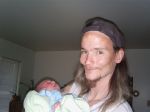 As ill-considered and improbable shaken baby convictions accumulate, the stories of injustice find their way out.
As ill-considered and improbable shaken baby convictions accumulate, the stories of injustice find their way out.
It Happened to Audrey
Headlining this week’s good press, Audrey Edmunds’s book has hit the shelves. It Happend to Audrey, written with journalist Jill Wellington, is a from-the-heart dispatch from the front lines of the struggle.
Edmunds recounts her horror the morning a baby she was caring for seemed to choke on a bottle and quit breathing—and then her disbelief and terror as a diagnosis of shaken baby syndrome sent her to prison. Anyone who has been accused will recognize the warping of reality as investigators, social workers, and the courts accept the diagnosis, ignoring actual evidence that should have raised questions.
Four years after Edmunds’s conviction, the same medical examiner autopsied another little girl, who had been brought to the hospital with recurrent vomiting in the mid-morning. When the breathing problems and seizures started 17 hours later, medical imaging revealed a brain injury that had gone unnoticed all day by a series of medical professionals—a documented case of the “lucid interval.” Dr. Robert Huntington reported this case to a medical journal, and was forced to reconsider having testified to immediate symptoms at Edmunds’s trial. A state appeals court ultimately overturned her conviction in 2007, after years of work by law students under the direction of Keith Findley at the Wisconsin Innocence Project. Edmunds recalls her thoughts during a hearing along the way, as a series of child-abuse experts reiterated why they believed seven-month-old Natalie Beard had died from a violent assault at the hands of her last caregiver:
“No matter what their research, theories, formulas or experience said about Natalie Beard, there was only one truth: I did not shake or inflict traumatic brain injury on that child. The state’s presentation was pure conjecture. I was always thoroughly beaten by the ongoing lies.”

Katie Couric
Edmunds and Findley have taped a segment with Katie Couric, and are scheduled to appear on the Katie program tomorrow, Monday, December 10, at 3 pm, at least in my time zone.
Montana Innocence Project
Meanwhile in Montana, reporter Jessica Mayrer has published a well researched article in the Missoula Independent that considers the cases of three state inmates convicted of shaking infants.

Dave Wilkes with Gabe, 2008, courtesy the Wilkes family
- Robert James “Dave” Wilkes said his 3-month-old son Gabriel started making gurlging noises and then stopped breathing while lying on the floor of their new apartment. The prosecution convinced a jury that Wilkes had shaken his son to death. Now the Montana Innocence Project says their doctors have found evidence the boy suffered from a liver disease that could have caused his melt-down.
- Michael Reim of Helena requested a trial by judge this year instead of by jury, because of the complex medical evidence against him. After listening to prosecution doctors who said Reim’s son had been shaken, and to defense doctors who said the boy suffered from a clotting disorder, the judge ruled that Reim was guilty of abusing his son.
- Young mother and infant-care provider Nevada Ugalde of Billings said she left an 8-month-old in a crib while doing laundry on a June day in 2008, and returned to find him on the floor. At her trial, doctors testified that she must have assaulted the boy, as he couldn’t have suffered fatal injuries falling out of a crib 32 inches onto carpet.
Cathy Lynn Henderson
And in Texas the Court of Criminal Appeals has vacated Cathy Lynn Henderson’s 1995 conviction, also based on testimony that a short fall could not cause fatal injuries. At her trial, Medical Examiner Dr. Roberto Bayardo had called Ms. Henderson’s account of dropping the baby onto a concrete floor “impossible” and “incredible” as an explanation for his injuries.
In 2007, however, after reading Dr. John Plunkett’s paper on short pediatric falls and the evolving biomechanical literature, Dr Bayardo told the appeals court that he would no longer call the infant’s death a homicide but instead would list the cause of death as “undetermined.” Dr. Plunkett and a number of other experts also testified at the hearing. The court ruled in favor of Ms. Henderson, writing:
The court further found that Dr. Bayardo’s re-evaluation of his 1995 opinion is based on credible, new scientific evidence and constitutes a material exculpatory fact. The trial court concluded that applicant has proven by clear and convincing evidence that no reasonable juror would have convicted her of capital murder in light of her new evidence.
Interrogation Tactics Under Fire
Finally, with thanks to The Amanda Truth Project for the story, a teenage mother in Massachusetts whose videotaped confession was thrown out last year is now suing the city of Worcester. Police sergeant Kevin Pageau and his partner had bullied and lied to Nga Truong during hours of interrogation the day after the death of her toddler son. Reporter David Boeri at WBUR in Boston, which had sued for the release of the interrogation tapes, quotes the tapes and comments on them in his report:
Pageau: “Somebody hurt that baby, and we need to know who it was, and we’re going to find out who it was — either the hard way or the easy way.”
Truong: “I’m telling you everything.”
Pageau: “No, you’re not. Stop. Don’t lie to me.”
The detectives had no evidence. And the autopsy stated no cause of death. But the two detectives knowingly and deliberately told the teenager otherwise:
Pageau: “‘Cause that medical examiner told me that that baby was smothered. Does that change your story? We have scientific evidence that that boy was smothered to death.”
Pageau was not telling the truth, as he later testified. Lying to witnesses is often part of the playbook for detectives. But Superior Court Judge Janet Kenton-Walker would later rule that the detectives went beyond making knowingly false statements. She found they engaged in a pattern of deception, trickery and implied promises targeting “a frightened, meek, emotionally compromised teenager who never understood the implications of her statements.”
-Sue Luttner
If you are not familiar with the debate surrounding shaken baby syndrome in the courtroom, please see the home page of this blog site.

Thank you for a very rich entry here. There is the content of four posts rolled into one, providing a broad perspective on the issues. One is struck by the contrast between our rush to judgment and the decade or two it takes for thoughtful review.
Thank you to everyone for your support for me and other wrongful convictions. Audrey
Good work Sue.